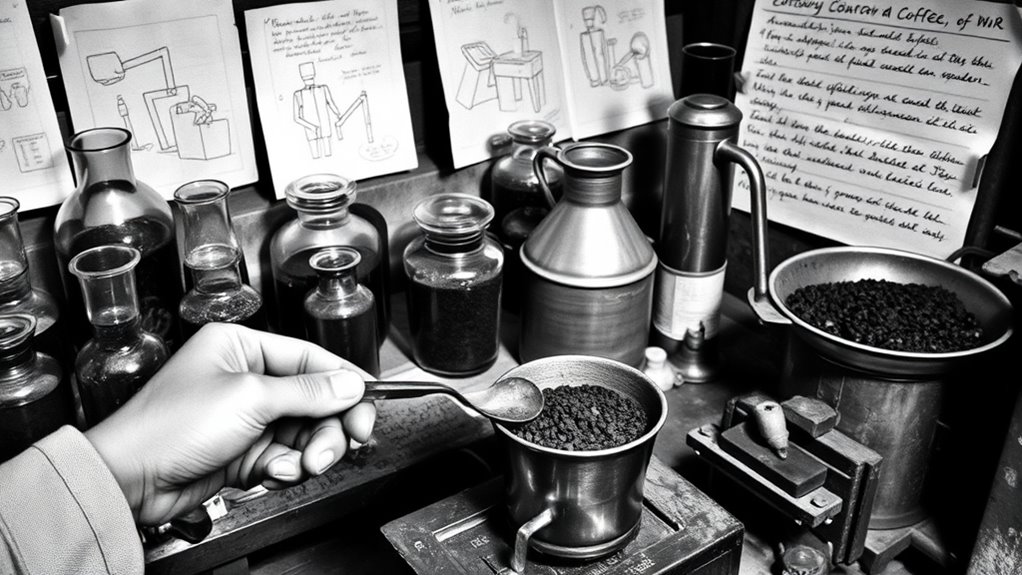You’ll discover that instant coffee started with early experiments drying brewed coffee into powders, but early versions lacked flavor. During World War II, it became a wartime staple as soldiers needed quick, portable caffeine sources. Innovations like freeze-drying improved taste, making it more appealing for everyday use. From its humble beginnings to its wartime prominence, the history of instant coffee is fascinating. Keep exploring to uncover how technology shaped its future.
Key Takeaways
- Early 20th-century experiments dried brewed coffee into powders, facing flavor and quality challenges.
- Instant coffee gained prominence during WWII as portable, long-lasting rations for soldiers.
- Innovations like freeze-drying and spray-drying improved flavor retention and aroma preservation.
- Post-war refinements focused on enhancing taste, leading to widespread household adoption.
- Modern advancements continue to improve instant coffee’s flavor profile, making it closer to fresh brewed coffee.

Have you ever wondered how instant coffee was invented? It’s a fascinating story that ties into the history of caffeine and how people have sought quick, convenient ways to enjoy their favorite beverage. The history of caffeine stretches back centuries, with coffee beans originating in Ethiopia and spreading across the Middle East and Europe. Over time, coffee’s complex flavor profiles—ranging from fruity and acidic to rich and nutty—became highly valued. Yet, despite its popularity, traditional brewing could be time-consuming, which pushed inventors to find faster solutions. That’s where instant coffee enters the scene, revolutionizing how people consumed caffeine on the go.
Instant coffee revolutionized caffeine consumption by offering quick, convenient enjoyment rooted in centuries of coffee history and flavor innovation.
The quest to create a soluble coffee started in the early 20th century. Innovators experimented with drying brewed coffee into powders or granules, but early attempts often resulted in products with poor flavor retention and inconsistent quality. They struggled to preserve the coffee’s aroma and flavor profiles, which are essential for satisfying coffee lovers. It wasn’t until the 1910s and 1920s that significant breakthroughs occurred, leading to the first commercially successful instant coffee. These early versions still lacked the depth of freshly brewed coffee, but they offered unmatched convenience—an essential factor during wartime. Technological advances in drying methods significantly improved the quality of instant coffee.
During World War II, instant coffee gained even more prominence. Rations were introduced to supply soldiers with a quick caffeine fix, and instant coffee’s portability and long shelf life made it ideal for military use. Soldiers appreciated the ability to prepare a hot drink simply by adding water, especially in challenging conditions. The war accelerated technological advances in freeze-drying and spray-drying methods, which helped preserve more of the original coffee’s flavor profiles. Thanks to these innovations, instant coffee became more flavorful and closer to traditional coffee, satisfying a broader audience.
Post-war, companies refined their processes, focusing on improving taste and aroma retention. They experimented with different coffee bean blends and roasting techniques to enhance flavor profiles, making instant coffee more appealing to consumers. Over time, instant coffee transitioned from a wartime novelty to a household staple, especially for busy individuals who valued quick caffeine boosts without sacrificing too much flavor. Today, it continues to evolve, with specialty instant coffees boasting rich, complex flavor profiles that mirror freshly brewed options.
In essence, the invention of instant coffee was driven by the desire for quick caffeine access, rooted deeply in the history of caffeine consumption and the pursuit of capturing the complex flavors that make coffee such a beloved beverage. From early attempts to modern formulations, it’s clear that convenience and flavor have always been at the heart of this innovation. Additionally, advancements in preservation techniques, like freeze-drying, played a crucial role in maintaining coffee flavor and aroma during processing. As technology progresses, the quality and variety of instant coffee are expected to continue improving, making it even closer to freshly brewed coffee.
Frequently Asked Questions
Who Was the First Person to Patent Instant Coffee?
You might wonder who first patented instant coffee. In patent history, the earliest patent for a process related to coffee extraction was granted to Satori Kato in 1901. He developed a method to create soluble coffee, making brewing quicker. This innovation marked a significant step in instant coffee’s development. So, Kato was a pioneer who changed how we enjoy coffee today, transforming traditional brewing into a faster, more convenient process.
How Did Instant Coffee Impact Global Trade During WWII?
During WWII, instant coffee revolutionized military logistics and international trade by providing soldiers with a quick, lightweight caffeine source. Its portability made it ideal for wartime rations, reducing reliance on bulky, perishable goods. This boost in supply efficiency encouraged global trade, as countries exported and imported instant coffee to meet wartime demands. Overall, instant coffee’s role helped sustain morale and operational effectiveness, shaping international trade dynamics during the war.
What Were the Main Challenges in Developing Instant Coffee?
You face challenges in developing instant coffee, mainly with drying techniques and flavor preservation. You need effective methods like freeze-drying or spray-drying to remove moisture without sacrificing taste. Balancing these techniques is tricky because drying can dull flavor, so you must find ways to preserve the coffee’s aroma and richness. Overcoming these hurdles helps create a convenient product that retains the original coffee’s qualities.
Did Early Instant Coffee Contain Additives or Preservatives?
You might wonder if early instant coffee contained additives or preservatives. Back then, additive controversies and preservative debates were common, so manufacturers often added preservatives to extend shelf life. Some early formulas did include additives to prevent spoilage, but many aimed to keep ingredients simple. Over time, consumer preferences shifted toward purer products, reducing the use of preservatives. Today, many instant coffees are preservative-free, catering to health-conscious consumers.
How Did Consumer Preferences Influence Instant Coffee’s Evolution?
You see, consumer preferences greatly shaped instant coffee‘s evolution. As people sought more appealing flavors, manufacturers responded by experimenting with new blends and additives to meet these changing tastes. Consumer trends pushed for convenience without sacrificing flavor, leading to innovations like improved processing methods and flavor enhancements. Your preferences for richer, more natural tastes influenced how instant coffee developed, making it more satisfying and tailored to your evolving flavor preferences.
Conclusion
So, next time you grab a quick cup of coffee, think about how it all began with early experiments and wartime innovations. Isn’t it fascinating how a simple idea transformed your morning routine? Instant coffee isn’t just a convenience—it’s a result of ingenuity and resilience. Without those pioneering efforts, would you still be savoring your favorite brew with such ease? Truly, history brews in every cup we enjoy today.









